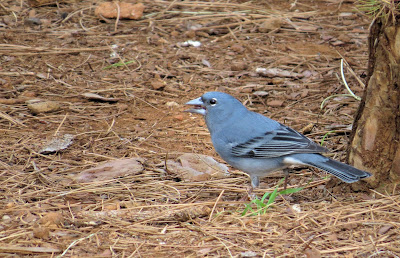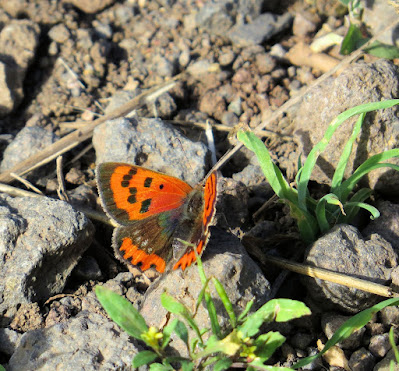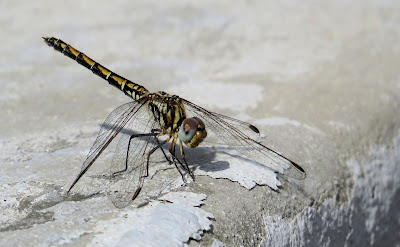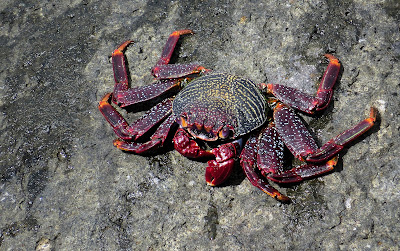Our base for the month was at Bajamar on the north coast of the Anaga peninsula in the northeast of the island. A good base for exploring the wetter, forested mountains but we had a car so were able to travel further afield.
BajamarThe immediate surroundings of our apartment were mainly small scale agriculture and held some good wildlife. One of the first birds encountered was Canary Islands Chiffchaff, the unfamiliar song heard from the balcony immediately drawing my attention. Very common on the island in most areas.
 |
| Atlantic Canary Serinus canaria |
Up to 5 Common Kestrel around this area with others seen elsewhere around the island.
 |
| Common Kestrel Falco tinnunculus canariensis |
Four Barbary Partridge were in the area (one of four sightings during the month).
 |
| Barbary Partridge Alectoris barbara |
This was the only place we encountered West Canary Skink.
 |
| West Canary Skink Chalcides viridanus |
Balsas de Tejina
Nearby are a few reservoirs, not all accessible, the best of which is at the roundabout leaving Tejina towards Bajamar. Three Black-crowned Night-herons were there on the 5th and a single Glossy Ibis on two dates. A Garganey was present throughout. Three African Blue Tits also here on one date.
 |
| African Blue Tit Cyanistes teneriffae |
I did get one other shearwater. On 27th February a Manx Shearwater flew north (the only sighting). This showed very well and had rather dark underwings consistent with the putative "canariensis" subspecies described in this paper. The local population of Manx breed earlier than northern birds and nest inland among the laurel forests. It may be severely threatened.
Otherwise I recorded 2 Gannets each on two days and the most bizarre sighting; a Barbary Partridge flying over the sea close inshore, which then landed and swam on the sea for while.This rocky stretch of coast also had up to 3 Grey Plover, 9 Common Ringed Plover, 6 Whimbrel, 11 Turnstone and 2 Common Sandpiper. It was also one of the only places I saw Spanish Sparrow (up to 4) and Berthelot's Pipit (2).
Parque Rural de Anaga
One of the advantages of being based in the north of the island was being close to the Anaga Rural Park; one of the better areas to search for the two endemic pigeons of the island. Multiple visits may be necessary as the weather in these mountains often closed in shrouding everything in cloud and making viewing impossible.
On my first two visits I saw single Laurel Pigeons at Los Batanes (at the lower edge of the laurel forest) and Pico de Inglés. But it took a third visit, once again watching from the excellent viewpoint of Pico de Inglés, to locate a single Bolle's Pigeon. On this longer stake out 3 Laurel Pigeons showed, one of them repeatedly rather close and often obscured by the trees directly below and often calling/singing. It was occasionally possible to see one perched. Then, as I was driving back through dense woodland close to this spot, a Bolle's Pigeon flew out and directly along the road in front of the car extremely close. |
| Canary Islands Chaffinch Fringilla coelebs canariensis |
Other species seen here were Common Buzzard, Raven, Canary Island Chiffchaff, Tenerife Goldcrest, Blackbird, European Robin and the rather splendid Canary Island race of Common Chaffinch.
Las Raices
Tenerife Blue Chaffinch Fringilla teydea
This Área recreativa is in the northern tip of the Corona forestal, an extensive region of (largely replanted) pine forest at an altitude of 1-2000m surrounding the central plain and volcano. The hiking routes around here are easy and in open pine woodland, a pleasant change from the dense laurel forests where views are hard to come by. Birdlife was fairly thin on the ground while walking in the forest but around the car parks and picnic areas there were up to 6 Tenerife Blue Chaffinch.
There was also a Canary Islands Common Chaffinch here, 2 Tenerife Goldcrests and 4 canariensis Great Spotted Woodpeckers. African Blue Tit was particularly numerous here with up to 11. A Barbary Falcon also flew over.
 |
| Tenerife Great Spotted Woodpecker Dendrocopos major canariensis |
This was one of only two places we encountered Tenerife Gecko
 |
| Tenerife Gecko Tarentola delalandii |
We also saw this well at the Barranco de la Cruz, La Quinta (just NE of Puerto de la Cruz), where there were many Tenerife Lizards and a good number of small birds.
El Teide
El Teide rising above a sea of cloud
The jewel in Tenerife's crown is without doubt El Teide. On clear days we could see the mighty peak from our apartment some 43km away. Variable amounts of snow covered the 3715m peak and while my sister and brother inlaw were visiting us we decided to visit and booked the cable car to the summit.
The day of the trip was clear and sunny but rather cold and as we reached the Área Recreativa Ramón el Caminero at around dawn we found the gates closed due to icy conditions higher up. To be fair it was like glass in places here at about 1580m too. As time ticked by we were clearly not going to make our booked time for the cable car to the top of the volcano but were told we could rebook for a later time once there. Eventually, after seeing a female Tenerife Blue chaffinch here (and nothing else) we were on our way again through the very impressive scenery of the coronal forest and volcanic "cañadas" plain, all the time with the massive conical peak dominating to the south.
We got to the cable car car park and after some confusion got booked on but while waiting in the queue the whole thing was shut down due to adverse conditions at the top. It was just too cold and windy and even those that had managed to get up there were not able to leave the terminal. In the end that would have been a very expensive trip so we were quite glad to accept the refund and enjoy the rest of the time walking in the dramatic volcanic landscape. Wildlife was limited to one Common Kestrel and an unidentified small bird that may have been a Berthelot's Pipit.Playa de las Americas
We always fancied a trip to the south of the island. While picking up and delivering Jane and David from the airport we were struck by the difference in the climate; so much warmer and drier. Then news came of a wintering Semipalmated Plover - a species I'd been researching, while keeping a close eye on all the Common Ringed Plovers I'd been seeing. So we drove the hour or so to a very busy Playa de las Americas and spent the day there.
I found the waders and eventually located a much slimmer bird (especially seen head on) with a very narrow yellowish eye ring and rather narrow breast band, uniform in width. Outer palmations were visible but seeing the inner palmations was extremely difficult and I had, inexplicably, left my camera with Karen while I negotiated the rocky shore, so this feature wasn't particularly helpful. I did note more white in the lores though but not the shape of white above the gape. Photos would have been very helpful but, along with hearing the rather Spotted Redshank like sharp high "ch-wit", convinced of the ID of Semipalmated Plover. A species I'd like to see again well enough to photograph.
I did make another trip to the same spot a couple of days later to try again for photos but the tide state meant most waders were roosting well out of range on a breakwater. On that visit though I did get superb scope views of several Long-finned Pilot Whale.
Other waders were Common Ringed Plover, Turnstone, Sanderling, Whimbrel, Grey Plover, 1 Dunlin and 1 Common Sandpiper, with many Cory's Shearwaters, a few Gannets, a few Black-headed Gulls and up to 50 Sandwich Terns offshore. In the town were a handful of Plain Swifts around palms, Ring-necked Parakeet and the only Hoopoe of the stay.
Other Wildlife
Tenerife Lizard Gallotia galloti
This was pretty common throughout the island and often easy to photograph. Quite a difference in appearance depending on age.
Grapsus adscencionis
This vibrantly coloured crab was entertaining to watch on the rocky shoreline.
 |
| Canary Red Admiral Vanessa vulcania |
 |
| Canary Speckled Wood Pararge xiphioides |
 |
| Plain Tiger Danaus chrysippus |
 |
| Scopula guancharia |
 |
| Small Copper Lycaena phlaeas |
 |
| Small White Pieris rapae |
Others
 |
| Annulated Sea Hare Aplysia dactylomela |
 |
| Broad Green-winged Grasshopper Aiolopus strepens |
 |
| Iberian Green Frog Rana iberica |
 |
| Mayfly Ephemeroptera |
 |
| Red-veined Dropwing Trithemis arteriosa |
 |
| White-banded Digger Bee Amegilla quadrifasciata |
Barbary Partridge
Rock Dove
Bolle's Pigeon
Laurel Pigeon
Collared Dove
Laughing Dove
Plain Swift
Common Moorhen
Eurasian Coot
Grey Plover
Common Ringed Plover
Semipalmated Plover
Whimbrel
Ruddy Turnstone
Sanderling
Dunlin
Common Sandpiper
Black-headed Gull
Yellow-legged Gull
Sandwich Tern
Cory's Shearwater
Manx Shearwater
Barolo Shearwater
Northern Gannet
Grey Heron
Little Egret
Cattle Egret
Black-crowned Night-Heron
Glossy Ibis
Eurasian Sparrowhawk
Common Buzzard
Eurasian Hoopoe
Great Spotted Woodpecker
Common Kestrel
Barbary Falcon
Ring-necked Parakeet
Common Raven
African Blue Tit
Barn Swallow
Canary Islands Chiffchaff
Eurasian Blackcap
Sardinian Warbler
Goldcrest
Eurasian Blackbird
European Robin
Spanish Sparrow
Grey Wagtail
Berthelot's Pipit
Common Chaffinch
Tenerife Blue Chaffinch
European Greenfinch
Atlantic Canary









































